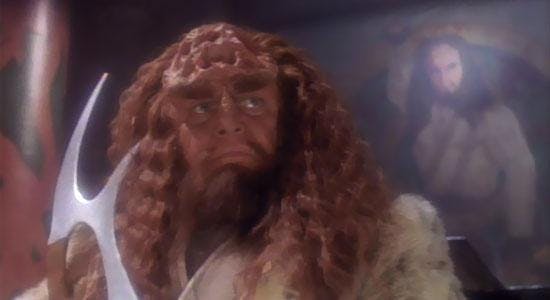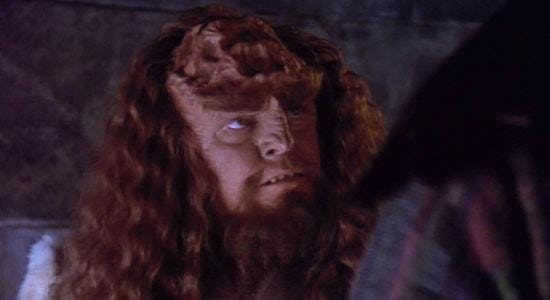Published Nov 23, 2016
Emperor Without Victories: The Case of Kahless the Clone
Emperor Without Victories: The Case of Kahless the Clone

Nothing delights an author more than working with a character who is struggling with inner conflict, and Star Trek has provided plenty of these. The first and most obvious example is Spock, working to reconcile his human and Vulcan heritages; in later years, Data andVoyager’s EMH both tried to figure out what it meant to be an artificial sentient being.

As a fan looking at the series' casts, I always found Worf’s plight the most interesting, in part because The Next Generation went to such lengths to flesh out Klingon culture. Certainly, we had seen Vulcan and Spock’s family in The Original Series, but TNG thrust the Enterprise and its Klingon crewmember headlong into disputes within the Empire, forcing Worf again and again to evaluate who he was — and whom he stood with. Along the way, it also introduced a character so riddled with fascinating internal contradictions that nearly a quarter century later, as an author, I couldn’t resist making him central not just to a single book, but an entire trilogy. I refer, of course, to Kahless. Not the Unforgettable, the legendary Klingon who founded the modern Empire, but the character wonderfully played by Kevin Conway in the 1993 TNG episode “Rightful Heir.”
Visiting the Boreth Monastery to rediscover his faith, Worf comes face to face with what appears to be the ancient leader, back from the dead. He soon uncovers the truth: using a drop of what they thought was the Unforgettable’s blood, the created a clone and stuffed his mind with the ruler’s sayings.

Fun stuff — but then the episode took a turn that delighted me further. Worf reveals the deception, but decides that the Empire is in such need of moral guidance that the clone should be elevated to the figurehead role of emperor. And while the incident threatens to undermine Worf’s own spiritual journey, the episode ends with one of my favorite speeches in all of Trek, in which the clone suggests that so long as the original Kahless’s teachings held merit, the literal fulfillment of prophecy was unnecessary. “If his words hold wisdom and his philosophy is honorable,” Kahless asked, “then does it really matter if he returns? What is important is whether we follow his teachings. Perhaps the words are more important than the man.”
Heady stuff for popular entertainment — and it stuck with me ever since. Further, I could see in Kahless, clone of Kahless, an even more complex iteration of the contradictions we’d seen elsewhere.

Consider: Here was an artificial being, born to be a legend. A legend among a people whose basic philosophy, which he existed to espouse, valued individual feats and action over all. What must it feel like to be the clone? He held a place of honor from “birth,” yet he had no battles of his own. No statues that he had earned.
Beyond that, the clone instinctively values Klingon traditions of family — yet he has no kin of his own. Did all his values come from his programming? He had been created to be steadfast. In practice, would his Klingon blood, borrowed though it was, give him his own identity? Or would he be rudderless?

It’s no wonder that, while we never again saw him on screen, when he was mentioned we got the sense that other Klingons regarded him skeptically. Kor disdained him in “The Sword of Kahless” in Deep Space Nine, calling him “a toothless figurehead” who was “cooked up in a vat” — and we could tell that even Worf was no longer sure what he thought of the emperor he installed.
It fell to prose to continue the tale of the clone’s life. An eponymous novel penned by Michael Jan Friedman in 1996 gave the clone a battle of his own, but cast doubt on both the Unforgettable’s legend while subtly questioning whether he was a clone of Kahless at all.

While he saw a little action after that in Deep Space Nine novels, the Emperor was put out to pasture — literally — in 2004. In A Time for War… A Time for Peace by Keith R.A. DeCandido, Kahless retired to a life of solitude on a sylvan world, stating that under Chancellor Martok, honor had been restored to the Empire. While there was more to that decision — as suggested in Kirsten Beyer’s 2009 Voyager: Full Circle — the character has remained on the inactive list for seven years of story and real-world time.
But while the Empire might have improved, I could see retirement giving the clone little solace. Would he really find his own way, divorced from his preprogrammed identity and destiny? Cloned or not, he was still Klingon. Would peaceful isolation be a balm for him, or a spiritual death sentence?

These questions occurred anew to me while I was developing Prey, my new Pocket Books trilogy in current release. Having written my first Star Trek: The Next Generation novel, Takedown, for Pocket Books in 2015, I had brought my editor, Margaret Clark, a concept for an epic trilogy wherein the 24th century cast would suffer its own version of the crisis in Star Trek VI: The Undiscovered Country: a rupture in Federation-Klingon relations caused by an incident in which Starfleet is at least partially at fault. There were also strains in the plot relating to the use of impersonation in Star Trek storytelling, and there had certainly been a lot of that — with the clone of Kahless being Exhibit A. When Margaret suggested this could be the opportunity to bring the clone out of exile, it was, for me, the chance of a Trek fan’s lifetime. All the tumblers fell into place quickly.
The trilogy began in September with Book 1, Hell’s Heart, which introduced another Klingon with a connection to the past: Korgh, the self-declared heir to Commander Kruge, Christopher Lloyd’s character from Star Trek III: The Search for Spock. That had long been one of my favorite films, in part for introducing both the Klingon language and one of the coolest starships ever, the Bird of Prey. Kruge, as movie fans know, had a very definite view on what it means to be a Klingon — it’s easy to imagine what he would have thought of the Federation’s eventual alliance with the Empire. The Prey trilogy imagines it and more, with Korgh seeking revenge in 2286 on Captain Kirk for his mentor’s death. And a century later in 2386, Captain Picard and Admrial Riker realize that there’s a lot of truth to that certain Klingon proverb about revenge served cold.

Many are mobilized to act against these threats, but Kahless and Worf face specific challenges that tie into their personal histories. The clone of Kahless is forced to confront having lived a life of status based on honors he did not earn. His mind is full of the teachings of Kahless the Unforgettable — including the qeS’a’, known to readers on Earth as The Klingon Art of War, from Gallery Books. What would the ancient leader think of the life the clone has lived? Would the Emperor be worthy of Sto-Vo-Kor?
And then there’s Worf — now 20 years of story time away from the wonderful episode “Sins of the Father,” and the discommendation that cost him his name and identity as a Klingon. His shame then was unearned, and he was able to escape the full emotional impact by returning to Starfleet. But what of others who didn’t have such an option — and, more importantly, what of their descendants? The sins of the father are visited upon seven generations, we are told. What does it mean to be born, to live, and to die with no chance of honor at any point? In the first installment, Worf meets a group of Klingons who know the answer only too well.

Prey Book 2 - The Jackal’s Trick was released in October, and the concluding volume, Book 3 - The Hall of Heroes, is starting to appear in bookstores now, with the digital and general release set for November 29. An audio rendition of the trilogy will follow in early 2017. It’s been a rewarding experience, a deep dive into Klingon society with some exciting action sequences involving a squadron of my favorite ships from Star Trek.
Most important, the trilogy afforded the chance to briefly help Worf and the Emperor along in their personal quests. That’s nowhere near enough to get an author into Sto-Vo-Kor, but as long as it entertains, my mission is accomplished. Qapla’!
John Jackson Miller is the New York Times best-selling author of novels and graphic novels in the Star Trek and Star Wars universes, as well as work for the Halo, Iron Man, Mass Effect, and Planet of the Apes franchises. He can be found on Twitter at @jjmfaraway and at his website, www.farawaypress.com.

